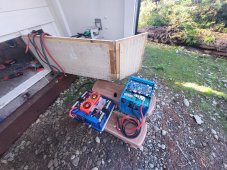Whats-n-Watts
New Member
Ok it helps that they are ground mounted. 5 panels in parallel * 2 arrays- that's going to be some thick expensive wire. I haven't pulled a calculator but I'm guessing 6ga thhn * 250ft?
Btw which charge controller? Midnite classic 150 x2 is $900
Victron 150/100 x2 is $1000. Add 6 awg wire and you are at the price of an aio just in charge controllers and wire.
Then you have to buy an inverter. I think for your use case an aio like the 6000xp would work better.
Or buy two lv6048 for $700 each and have one as a spare
6,000 watts can handle 2 refrigerators, 2 freezers, a well pump, 950 watt air-conditioner and a 5,600 watt dryer all coming on at once? Someone told me in this forum I was pushing my luck with a 2,500w for just the cold storage appliances.
I'm not sure but what I calculated for 3 in series with 5 series in parallel I need a SCC rating for 47.1a at 188.26v which would be 15 panels for each controller utilizing all 30 in my pallet.
I may go back to my original plan and set the shed with appliances up on its own system and do the same with the well pump since it's 120 or so feet from the house. It's power is currently grid tied and the existing wire runs away from the new house so it's either run another wire or just put it on a mini system and be done with it and not worry about it invthe house system. So yeah if 6,000 watts will do it then great!
I have a business and wire isn't quite as much for me as it is for the general public with contractors pricing but smaller is definitely better.
If there is a better way then I am all ears. I'm hear to learn from you guys and make like minded friends. Not too many people in my area are keen about solar. Quite the opposite as it's frowned on because of appearance.




